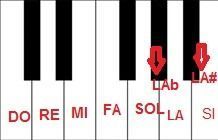Piano Keyboard – How many keys does a piano have?
It’s curious but one of the most recurring questions people ask about the piano is, what is the difference between the black and white keys?
Many people by simple culture know that the musical notes are DO-RE-MI-FA-SOL-LA-SI (C-D-E-F-G-A-B in english system). But of course this can lead us to think. How is it possible that there are only seven notes if a piano has up to 88 keys and most 61 keyboards?
Jaime Echagüe
Author
Advice:
Don’t miss the selection of BuscarInstrumentos.com with the best piano keyboards of the moment, we evaluate the quality in relation to the price of the keyboard.
This is possible because the 7 notes we already know form a block that is called an octave and is repeated along the keyboard. The octaves to the left of the piano are the lowest notes and the octaves to the right are the highest.
In the previous image we can see a complete block of keys. From the C on the left to the C on the right there is a distance of one octave: C-D-E-F-G-A-B-C.
This is a bit confusing because you’ll wonder how this C differs from the other and why there are no more notes. For pure usability our 7 note tonal system was defined and then these are repeated towards the treble or bass in blocks of 7 notes. At a simple convention. In the background, each note is associated with a specific hertz. So a serious C will have some hertz and a more acute C will have some hertz. Both notes, although called C, are different sounds.
It must be taken into account that although they are different sounds between one DO and another there will always be a distance that can be measured in octaves. Equal between a serious SI and a more acute SI.
The Nordic and Anglo-Saxon countries call notes with German notation (although it is also called American notation). In the following image you have the equivalence, ours is the Italian school.
What is the difference between black and white keys?
I’m sure you’ll be interested in…
- Ranking with the best digital pianos in quality-price ratio
- The cheapest musical keyboards for beginners
- Learn piano by yourself and for free
As we have already explained to you, our tonal convention system is made up of 7 notes. These natural notes are C-D-E-F-G-A-B and are the white keys. And that means there are no notes in between? Well, there are, and these are the black keys.
The distance between the keys or notes could be measured in Hertz but this is not the case. They are measured in tones and semitones and not all notes have the same distance between them. According to our tonal system between the C and the B there is no intermediate note. Just like between E and F. What it is when we see two white keys in a row without a black key in the middle.
To explain the black keys I will try to be as clear as possible with an example. The black key between A (LA) and G (SOL) is a musical note in between and can be called in two ways; F sharp (represented as F#) or G flat (represented by Gb). Both notes are the same note in Hertz, the distance from a white key to its immediate black key will always be half tone. And the distance between two whites if there is a black key in the middle will be one whole tone or 2 semitones.
It is a more complex concept but a F sharp is a note F with a semitone added, which is the same as Gb which means to subtract a semitone. At the end you look at it as you look at it you fall in the black key that is between them. We put you the following image with other examples so that you see the one that means flat and sharps:
If you are left with any doubt, watch this video with which you will surely understand everything perfectly.
Virtual Piano Keyboard or a real piano keyboard?
So far we have explained to you what the keyboard of a piano is like and what each key is like. Now you might want to know how to test sounds on a real or virtual keyboard.
If you don’t have a real electronic piano keyboard you can use a piano keyboard simulator to do the first experiments. The most comfortable thing is to use a tablet because its touch screen is the closest thing to a piano and the specific iPad brings the GarageBand. With a fairly intuitive and simple piano extension… it is free and has many more instruments.
For Android you have Perfect Piano that is quite well in its free version.
The tactile piano simulators can be used for the first approaches but are rather limited to learn piano. They’re good for testing chords and seeing how they sound, that’s for sure.
A piano keyboard is a keyboard that tries to imitate an acoustic piano as much as possible. The most important thing for this is that it has at least 61 keys and that these are sensitive to the force with which they are pressed. On the other hand if the keys have weight (Hammer Action) they will get closer to the real touch of a real piano.
The above factors are very important when playing the piano with expressiveness and nuances. Today you have keyboards and digital pianos that emulate acoustic pianos very well. So we can study music perfectly about them and save a lot of money.
If you are thinking of buying a digital piano keyboard visit our guide of the piano where you will know what types there are, the different sizes and measures you have at your disposal and all the possibilities they offer you to compose your own music.
You can start with a 61-key piano keyboard, for example. Less than 61 keys we do not recommend because that will limit you a lot in the future. You have Yamaha piano keyboards at a good price for example.
If you want to know more about music theory and how to play the piano visit our free piano tutorial.On the other hand you have to know that nowadays with the new technologies an incredible world is opened in the learning of the piano. Even self-taught. If you want to know more, don’t hesitate to visit our piano learning guide.If you liked the article and think it could be useful to someone, don’t hesitate to share it on your social networks. Thanks for reading!
Vote if you liked this article 🙂





